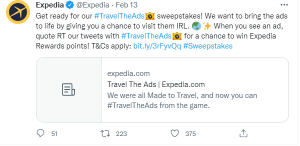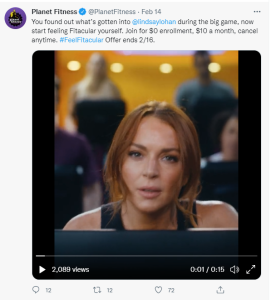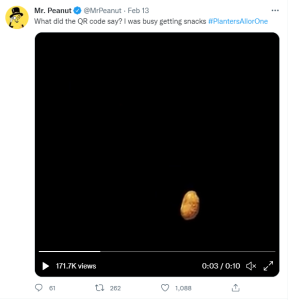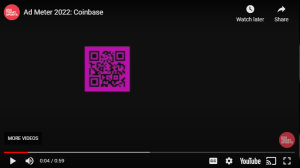Social Butterflies Emerge from Super Bowl LVI
In the early days of social media, very little creativity and effort was put towards crafting a dedicated social media marketing strategy. During major brand awareness moments like the Super Bowl, social platforms were used by brands for the sole purpose of having an additional placement for TV ads. At the time, and after spending millions in production costs, it seemed like the most rational and cost effective move.
Fast forward to 2022, the chances of finding an un-altered, full-length TV commercial slotted in a paid social media ad is almost unheard of. Brands now understand that media consumption on social media is entirely different than that of TV, and they make a concerted effort to transfer the main theme of major brand spots to each respective platform.
Join the conversation
Real-time dialog is no longer just for viewers. Brands can leverage their social platforms to join the conversation.
Twitter has long been a favorite platform for real-time conversation. Viewers started using the platform to make predictions, voice their opinions, and connect with other viewers in the nascent stage of social media. Today, real-time conversation happens on every channel. Newsfeeds and home pages fill with relevant memes in a matter of seconds, and brands have joined in on the action.
Expedia took a clever twist on game-time engagement by posting the various destinations showcased in Super Bowl ads, and asked viewers to retweet for a chance to travel to that destination.

Break through the noise
Listen to what your consumers have to say. Social listening is often looked upon as a reactive marketing tool to evaluate sentiment and engagement after a new product or campaign launch. While using social listening can help brands make corrections for the future, mistakes can be avoided all together if used from a proactive standpoint. In fact, many brands have turned to social listening to uncover ways to market an existing product to a new audience, or made campaigns around a culturally-relevant attribute, as was the case with Pringles. The snack company based the plot of their Super Bowl LVI commercial on the universal pain-point of consumers – getting their hands stuck when grabbing Pringles out of the can.

Build your cast with intention. Brands have been following the age-old tradition of incorporating A-List celebrities for decades, noting it as a necessary component to a successful campaign during a major brand moment. While doing so may garner a lift in attention, the natural fit of the brand/celebrity partnership carries more weight than the volume of the celebrity’s fanbase. For example, Planet Fitness built its entire commercial around Lindsay Lohan, creating a synergy between her transformation to a healthy lifestyle and the goals of its gym-members.

Create momentum ahead of launch day. Plan ahead and create relevant content designed for each social media channel ahead of launch day. Callaway Golf predicted the outcome of the Super Bowl with the help of a trick-shot content creator. Frito Lay used its Instagram page to post game-day recipes. Kia enlisted the help of @dougthepug on TikTok to spread the word about its CSR campaign ahead of Super Bowl Sunday.
Leaking your key marketing messaging has more benefits than drawbacks. Although it may seem lucrative to keep the ad under wraps until the big day, uploading the content to owned channels has several benefits. It gives viewers the opportunity to ingest the message on their own time in a calmer environment, and establishes a basis for brand recognition when aired again. The social component provides the dual benefits of brands taking note of real-time reactions, and consumers interacting in comments to point out features that may not be understood by everyone. Finally, if the ad is not well-received, it can stop a brand from provoking considerable damage to its reputation.
Engage with the audience throughout the event in a clever and authentic way. After seeing how much attention was garnered by Coinbase’s viral Super Bowl spot, the marketing team at Planters acted swiftly and tweeted a satire video in response. The bold and quick-natured move by Planters won the brand an award at Twitter’s 2022 Brand Bowl.

Think outside the box like State Farm
State Farm opted for a TikTok hashtag challenge instead of a game-time commercial. On January 22, State Farm officially kicked off its Super Bowl challenge on TikTok, offering users the chance to be featured alongside Jake from State Farm in a new commercial. Users have to use TikTok’s duet feature and the hashtag #TeamStateFarm to create an engaging video. On Super Bowl Sunday, the best three videos will be pinned to Jake’s TikTok and users will pick the winner by liking their favorite video.
The insurer decided to forgo a typical TV ad—a channel which they stated was widely successful last year—to instead offer a unique experience to TikTok users everywhere. The brand wanted to leverage the creativity of the platform while also reaching a new generation of consumers where they’re spending their time.
#Teamstatefarm trended on TikTok with over 12.3M views and hundreds of participants.
To make the most of its paid social investment, State Farm reduced media spend in the two weeks leading up to the super bowl and began increasing spend one week post-game. Using this flighting strategy gives the brand the ability to more accurately measure results from its #teamstatefarm campaign, without sacrificing lost conversion from top-performing and highly-trackable media channels like Facebook and Instagram.
In the week leading up to Super Bowl 2022, State Farm had a 152% increase in post volume compared to that of Super Bowl 2021’s 76% increase. This shows that opting for a digital-first activation in favor of a prime-time branding moment can help a brand achieve sustained buzz. he combination of the early announcement, the engaging challenge, and the attention this campaign received gave State Farm more momentum leading up to the Super Bowl and exponentially increased brand engagement over a longer period without increasing spend.
Taking a digital-first activation approach and engaging with younger audiences where they are helped the insurer to achieve their goal of reaching a new generation of consumers.
The average age of post authors during State Farm’s 2021 Super Bowl ad was between the ages of 35-44, while in 2022 the average age range shifted to 25-34. State Farm’s use of TikTok created a fun way to connect, engage, and foster relationships with a new generation of potential customers.
Simple yet effective like Coinbase
Coinbase stole the show with its simple, yet effective, TV spot. Not only did this Coinbase ad break every rule of marketing, it broke the internet. From DVD-era nostalgia to the timeliness of QR-code popularity, this :60 ad proved the power behind incorporating a second-screen experience to a TV-ad.

Consumers had mixed feelings towards the ad, but it was undoubtedly the most talked about brand of the day. Looking at the entirety of Super Bowl-centric online conversations, Coinbase experienced a 984% increase in conversations the week after the ad was released. However, only 48% of those conversations were positive.
The 48% of posts that were positive mentioned the ad being “so clever”, or that it “wins for the best #fintech @superbowl ad”, while the negative conversation centers around the app crashing after authors engaged with the star of the ad, the QR code. While sentiment can be an indicator of a successful campaign, it is important to dig deeper into online conversations to understand the driving factors and how they impact the brand.
What we think
The future of brand campaigns are multi-channel and timeless.
Second-screening is here to stay. This year, brands proved that having an online campaign presence is crucial to a successful brand awareness campaign. Moving forward, brands will need to continue innovating around the second-screen experience to fully capture the attention of their audience, especially as gen z ages and a new generation of tech-savvy consumers emerge.
Brand relevance before cultural relevance. Cultural relevance is short-lived, making it difficult to conceptualize, produce, and launch a campaign before the clock runs out. In 2021, consumers pleaded for brands to stop mentioning the unprecedented time of Covid in ads. In 2022, the metaverse was not as widely understood as many anticipated, which left viewers confused when brands focused campaigns around it. Instead, brands should spend more time learning about synergies between their brand and their targeted consumers by means of social listening to produce content that is timeless and authentic.



